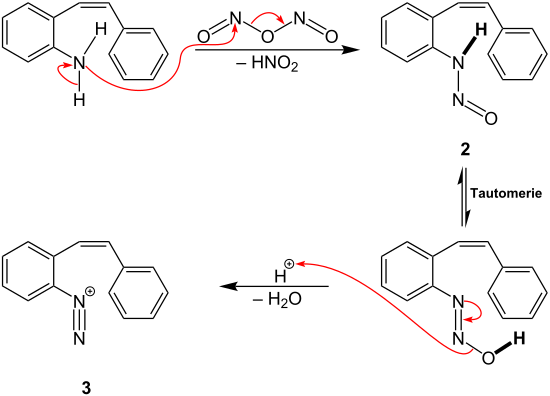Pschorr cyclization
This article needs additional citations for verification. (December 2021) |
| Pschorr cyclization | |||||
|---|---|---|---|---|---|
| Named after | Robert Pschorr | ||||
| Reaction type | Ring forming reaction | ||||
| Reaction | |||||
| |||||
| Identifiers | |||||
| Organic Chemistry Portal | pschorr-reaction | ||||
| Conditions | |||||
Catalyst
|
copper | ||||
The Pschorr cyclization is a

Reaction mechanism
In the course of the Pschorr cyclization, a diazotization of the starting compound occurs, so that an aryldiazonium salt is formed as intermediate. For this, sodium nitrite is added to hydrochloric acid to obtain nitrous acid. The nitrous acid is protonated and reacts with another equivalent of nitrous acid to the intermediate 1 which is later used for the diazotization of the aromatic amine:

The intermediate 1 reacts in the following way with the starting compound:[3]

Intermediate 1 replaces a hydrogen atom from the amino group of the starting compound. A nitroso group is introduced as new substituent, producing under the release of nitrous acid intermediate 2. Intermediate 2 then reacts via a tautomerism and dehydration to the aryldiazonium cation 3.

Nitrogen is then cleaved from the aryldiazonium cation 3 by the use of the copper catalyst. The aryl radical thus formed reacts via ring closure to the intermediate stage 4. Finally, rearomatization takes place using again the copper catalyst and phenanthrene is formed.
Atom economy
The Pschorr cyclization has a relatively good
References
- ^ ISBN 9780080444123
- ^ S2CID 93616494
